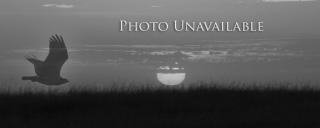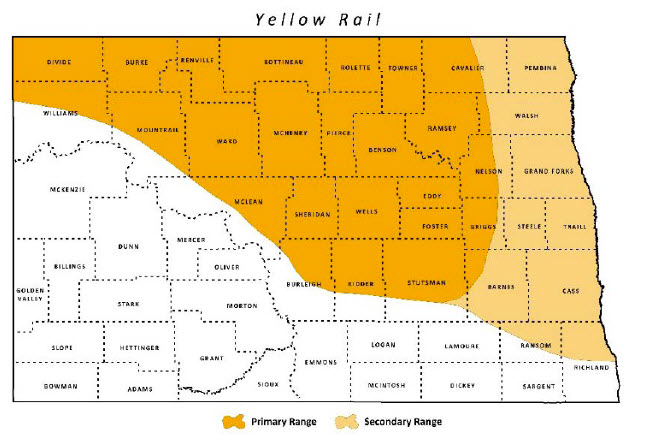
Yellow Rail
| Scientific Name | Coturnicops noveboracensis |
|---|---|
| General Description | L 7.25”, WS 11”, 1.8 oz. A cryptic and secretive bird, it is yellow-buff overall, striped back, short tail and stubby yellow bill. |
| Status | Occurs in North Dakota from mid-May to July. Peak breeding season occurs from early June to mid-July. |
| Abundance | Rare. |
| Primary Habitat | Fens or wet meadows with emergent vegetation, shallow water, and moist soil. |
| Federal Status | Migratory Bird. |
| Reason for Designation | Little is known about the Yellow Rail in North Dakota as it is an extremely shy, secretive bird and it is difficult to survey. Designated as High Concern in the Northern Prairie and Parkland Waterbird Conservation Plan (NPPWCP) and High Concern by Waterbird Conservation for the Americas. It is included on the National USFWS Birds of Conservation Concern list, and also in Region 6 and BCR 11 and added to the 2008 BCC list in BCR17. |
Locations and Conditions of Key Habitat
Preferred Habitat
Yellow Rails prefer fens or wet meadows dominated by sedges, grasses, rushes, and bulrushes in fresh and brackish wetlands. Wetland water depth of typically 0-46 cm. Rail presence is often associated with a high percentage of emergent vegetation. Nest under a canopy of vegetation in areas with standing water or saturated ground. Have been observed using wetlands as small as 0.5 ha, but will use wetlands up to 1,000 ha. Primary food includes snails, aquatic insects, and seeds.
Key Areas and Conditions for Yellow Rail in North Dakota
No specific sites have been identified. Yellow Rails are primarily found in the northern half of North Dakota. Possibly established populations in southwestern Benson County. The presence of this species may vary greatly from year to year depending on water availability.
Problems Which May Affect this Species
Habitat
Wetland destruction and/or degradation and conversion of upland Fens are rare and extremely vulnerable in North Dakota. Processes used to alter fens to create deeper, more permanent water are a threat to natural fens. Drainage of wetlands is another concern. The wetlands of North Dakota are extremely dynamic in nature. Fens that hold water one year may be dry the next. Invasion of hybrid cattails into these wetlands with little or no cattails is a concern.
Other Natural or Manmade Factors
Pesticide runoff from agricultural practices may affect wetland communities. Human disturbance from wildlife observers entering Yellow Rail habitat to get a glimpse of the rare birds could cause abandonment or destruction of nests. Yellow Rails may killed from machinery during mowing or haying. Mortality from collisions with communication towers and power lines. Expanding oil and gas development in North Dakota increases risk of oilfield contamination of wetland habitat.
Research and Survey Efforts
Current Research or Surveys
- Rocky Mountain Bird Observatory (ND SWG T-40-R) is conducting a statewide inventory of colonial and semi-colonial waterbird populations and identifying key sites for breeding colonies in North Dakota. The Yellow Rail is one of 29 target species. The project was initiated in March 2014.
Previous Research or Surveys
- Northern Prairie Wildlife Research Center (ND SWG T-3 and T-9-R) determined marsh bird distribution in relation to landscape composition in North Dakota. The project was initiated in 2004 and a final report provided in 2008. Yellow Rails were one of 16 focal species. Yellow Rails were primarily observed in the Drift Prairie (Sherfy and Anteau 2008).
Additional Research or Surveys Needed
- Development of effort-efficient survey techniques.
- Identify key sites and establish population monitoring at selected sites, determine site fidelity and breeding success. This could include re-surveying sight locations identified by Berkey.
- Develop better understanding of habitat selection and population size as they relate to wetland size, wetland characteristics, and wetland vegetation.
- Fair number of published reports and gray literature throughout the species range and in North Dakota.
Population and Trend Estimates
- Waterbird Conservation for the Americas Population Estimate: 10,000 – 25,000 individuals
- NPPWCP BCR11 Population Estimate: unknown
Management Recommendations
- Avoid water manipulation which creates a hemi-marsh or deep-water marsh.
- Maximize the coverage of emergent perennial vegetation.
- Use controlled burns to discourage woody encroachment.
- Discourage people (i.e. bird watchers) from entering known Yellow Rail nesting habitat, to reduce trampled vegetation and possible destruction of nests.
- Construction of communication towers should follow the guidance of “Service Interim Guidelines for Recommendations on Communications Tower Siting, Construction, Operation, and Decommissioning” and American Bird Conservancy Collision Program framework.
- Utility development should follow the guidance of “Reducing Avian Collisions with Power Lines” including marking power lines and Creating an Avian Protection Plan.
Monitoring Plans
The NPPWCP has identified the basic elements of how a regional/continental waterbird monitoring program should be structured. Waterbird monitoring should follow recommendations of the Waterbird Conservation for the Americas and North American Bird Conservation Initiative ‘Opportunities for Improving Avian Monitoring’.
2005-2015 Progress
The Yellow Rail remains a Level I Species of Conservation Priority. Efforts to identify key sites for breeding areas are underway. Several State Wildlife Grant Projects (T2-9-R, T-18-R, T-27-HM) have contributed to habitat enhancement of wetlands for Yellow Rail and other wetland dependent birds.

Note: A listing of works consulted when compiling the information on this page may be found in the 2015 State Wildlife Action Plan.
